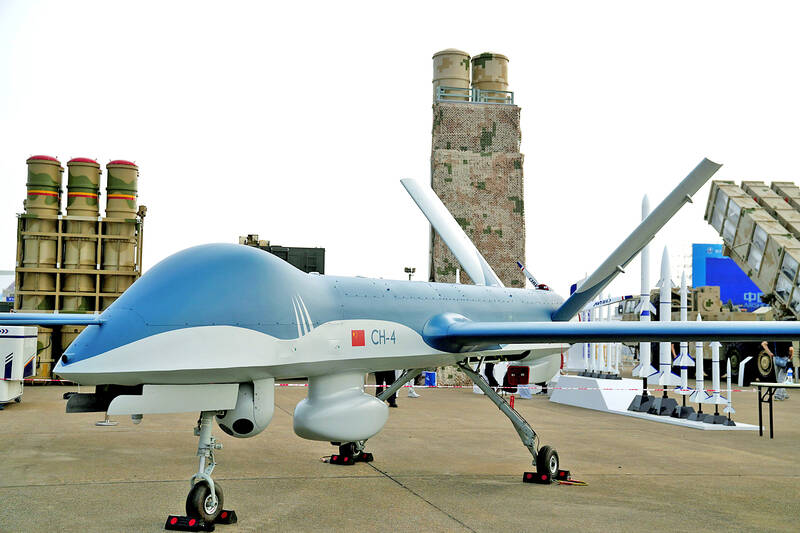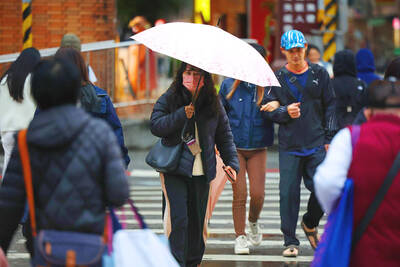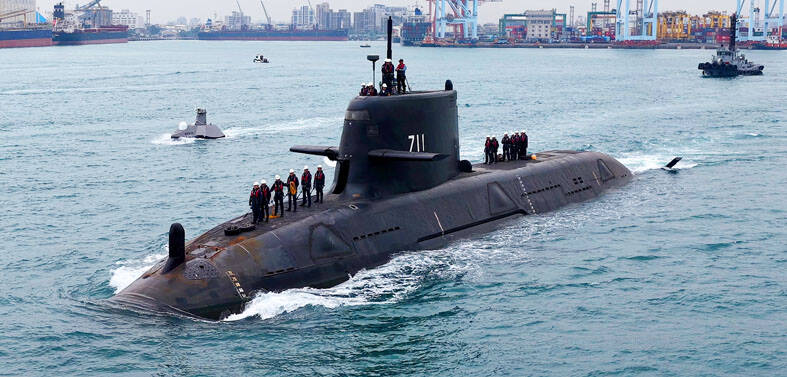Thirteen Chinese military aircraft entered Taiwan’s air defense identification zone from 6am on Thursday to 6am yesterday, including a drone that almost circumnavigated Taiwan proper, the Ministry of National Defense said.
Flight path information released by the ministry showed the CH-4 drone flying clockwise off the northern coast of Taiwan then traveling south. It was not shown flying northward to the west of the nation.
It was the third instance that Chinese People’s Liberation Army (PLA) drones have been detected on the eastern boundary of Taiwan’s air defense zone after drones were spotted on April 28 and May 3 on slightly different flight paths, the ministry said.

Photo: Reuters
An air defense identification zone is a region beyond a country’s territorial airspace, within which identification, location and air traffic control is required by a country for national security purposes.
The CH-4 “Rainbow” is an 8.5m-long, 18m wide reconnaissance and combat drone that China claims can fire air-to-ground missiles and fly at an altitude of 5,000m, making it difficult to bring down with standard anti-aircraft weapons.
The other PLA aircraft that entered Taiwan’s zone between 6am on Thursday and 6am yesterday were two other drones — a TB-001 and a BZK-005 — two Su-30s, six J-10s and one J-16, which are all fighter jets, and a Y-8 electronic warfare aircraft, the ministry said.
All of them, except the Y-8 and J-16, crossed the median line of the Taiwan Strait, while the J-10s and Su-30s remained close to the line before turning back, the flight paths showed.
The TB-001 and BZK-005 drones flew to the south and southeast in a counterclockwise direction relative to Taiwan, the flight data showed.
In addition to the aircraft that entered the zone, 19 other PLA planes and four vessels were detected in the region during the 24-hour period, the ministry said.
Taiwan dispatched aircraft and vessels to shadow the Chinese craft and locked onto them with land-based missiles, it said.

NUMBERS IMBALANCE: More than 4 million Taiwanese have visited China this year, while only about half a million Chinese have visited here Beijing has yet to respond to Taiwan’s requests for negotiation over matters related to the recovery of cross-strait tourism, the Tourism Administration said yesterday. Taiwan’s tourism authority issued the statement after Chinese-language daily the China Times reported yesterday that the government’s policy of banning group tours to China does not stop Taiwanese from visiting the country. As of October, more than 4.2 million had traveled to China this year, exceeding last year. Beijing estimated the number of Taiwanese tourists in China could reach 4.5 million this year. By contrast, only 500,000 Chinese tourists are expected in Taiwan, the report said. The report

Temperatures are forecast to drop steadily as a continental cold air mass moves across Taiwan, with some areas also likely to see heavy rainfall, the Central Weather Administration (CWA) said. From today through early tomorrow, a cold air mass would keep temperatures low across central and northern Taiwan, and the eastern half of Taiwan proper, with isolated brief showers forecast along Keelung’s north coast, Taipei and New Taipei City’s mountainous areas and eastern Taiwan, it said. Lows of 11°C to 15°C are forecast in central and northern Taiwan, Yilan County, and the outlying Kinmen and Lienchiang (Matsu) counties, and 14°C to 17°C

SHIPS, TRAINS AND AUTOMOBILES: The ministry has announced changes to varied transportation industries taking effect soon, with a number of effects for passengers Beginning next month, the post office is canceling signature upon delivery and written inquiry services for international registered small packets in accordance with the new policy of the Universal Postal Union, the Ministry of Transportation and Communications said yesterday. The new policy does not apply to packets that are to be delivered to China, the ministry said. Senders of international registered small packets would receive a NT$10 rebate on postage if the packets are sent from Jan. 1 to March 31, it added. The ministry said that three other policies are also scheduled to take effect next month. International cruise ship operators

STEERING FAILURE: The first boat of its class is experiencing teething issues as it readies for acceptance by the navy, according to a recent story about rudder failure The Hai Kun (海鯤), the nation’s first locally built submarine, allegedly suffered a total failure of stern hydraulic systems during the second round of sea acceptance trials on June 26, and sailors were forced to manually operate the X-rudder to turn the submarine and return to port, news Web site Mirror Daily reported yesterday. The report said that tugboats following the Hai Kun assisted the submarine in avoiding collisions with other ships due to the X-rudder malfunctioning. At the time of the report, the submarine had completed its trials and was scheduled to begin diving and surfacing tests in shallow areas. The X-rudder,